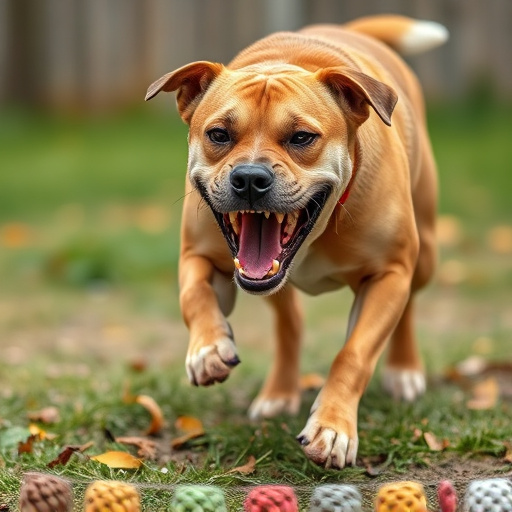Mace canine spray, using capsaicin to irritate dogs' senses, offers 3-5 meter (10-16 foot) pattern width for safe deterrence and control of attacks. Understanding and selecting appropriate spray settings, based on distance and angle, ensures maximum effectiveness against single or multiple aggressors while minimizing harm to bystanders. Responsible use involves training, de-escalation tactics, secure storage, and knowledge of local regulations.
“In the face of dog attacks, understanding effective self-defense tools like mace can be life-saving. This comprehensive guide explores mace canine spray as a powerful defense mechanism against aggressive dogs. We delve into its mechanics, analyzing the crucial factor of spray pattern width for optimal effectiveness. Learn how to choose the right mace, ensure safety during training, and master its use in various scenarios. By understanding mace canine spray, you gain a vital skill set for navigating potential dog attack situations.”
- Understanding Mace Canine Spray for Dog Attacks
- How Does Mace Canine Spray Work?
- Evaluating Spray Pattern Width Effectiveness
- Choosing the Right Mace for Canine Defense
- Training and Safety Measures with Mace Spray
Understanding Mace Canine Spray for Dog Attacks
Mace canine spray is a non-lethal self-defense tool designed to deter and control dog attacks. Understanding how it works and what to expect during its use is crucial for effective protection. The spray releases a fine mist containing capsaicin, the active ingredient found in chili peppers, which irritates the eyes, nose, and throat of the target animal. This irritation creates a distraction, allowing the user to escape or gain control of the situation.
The mace canine spray pattern width varies among models, but typically it has a range of around 3-4 meters (10-13 feet). This distance ensures that users can apply the spray effectively without putting themselves in excessive risk. The pattern width also determines how much coverage is provided, allowing for better protection during dog attacks. Knowing your specific spray’s pattern width and practicing its use in controlled environments can significantly enhance your ability to defend against potential canine threats.
How Does Mace Canine Spray Work?
Mace canine spray is a non-lethal self-defense option designed to deter and incapacitate aggressive dogs. It functions by releasing a stream of pepper spray with a specific pattern width, temporarily blinding and disorienting the target animal. The spray irritates the dog’s eyes, nose, and throat, causing it to react instinctively by retreating or becoming less aggressive.
The Mace canine spray pattern width is carefully engineered for maximum effectiveness. It creates a cone-shaped spray pattern that can reach up to 3 meters (10 feet) in ideal conditions, allowing users to maintain a safe distance from the attacking dog while still delivering a powerful deterrent. This controlled dispersion ensures that the spray covers a sufficient area to subdue the animal without causing harm to bystanders or the user.
Evaluating Spray Pattern Width Effectiveness
When selecting a mace for canine defense, evaluating the spray pattern width is crucial. A wider spray pattern ensures maximum coverage, increasing the likelihood of deterring an attacking dog. This feature is particularly important in situations where the attacker might be at close range or moving erratically, as it allows for a more comprehensive application of the pepper spray.
The Mace Canine Spray Pattern Width plays a significant role in determining its effectiveness. Modern mace devices often offer adjustable settings to control the spray pattern, allowing users to tailor their defense according to specific scenarios and environments. This adaptability ensures that you’re equipped to handle various dog attack situations, from a single, aggressive dog to multiple, coordinated attackers.
Choosing the Right Mace for Canine Defense
When selecting a mace for canine defense, understanding the spray pattern and width is paramount. Look for devices with adjustable settings that can target specific distances and angles. This ensures optimal coverage while minimizing collateral damage or risk to bystanders. The ideal mace should offer a wide range of patterns, from fine mist to powerful stream, catering to various scenarios and personal preferences.
Consider the can’s fill volume as well—a larger capacity allows for more shots, which is crucial during high-stress situations involving aggressive dogs. Always opt for high-quality products certified for self-defense use, ensuring reliability in moments that matter. Remember, the right mace is not just about stopping an attack but also about doing so safely and effectively.
Training and Safety Measures with Mace Spray
Training and safety measures are paramount when considering mace for canine attacks. It’s crucial to understand that mace spray, while effective in deterring and disabling aggressors, is a tool that should be used as a last resort and only when all other de-escalation techniques have failed. Proper training involves learning safe handling practices, understanding the spray pattern width (typically around 3-5 meters), and mastering the correct application technique to ensure maximum effectiveness while minimizing collateral damage or harm to bystanders.
Safety measures extend beyond proper usage. Storing mace securely, keeping it out of reach of children and pets, and being aware of local regulations regarding its possession and use are essential. Regular maintenance of the device, including checking expiration dates and ensuring proper functionality, is also vital for guaranteed reliability in a high-stress situation.
When faced with a dog attack, knowing how to defend yourself effectively is crucial. Mace canine spray has proven to be a reliable tool for deterring and controlling aggressive dogs. Understanding the spray’s mechanism, evaluating its pattern width for optimal coverage, and choosing the right mace are essential steps in ensuring your safety. Proper training and adherence to safety measures, including target practice and familiarizing yourself with local laws, will make you more confident and prepared when facing a potential dog attack. Remember, prevention is key, but being equipped with the right knowledge and tools can make all the difference.
